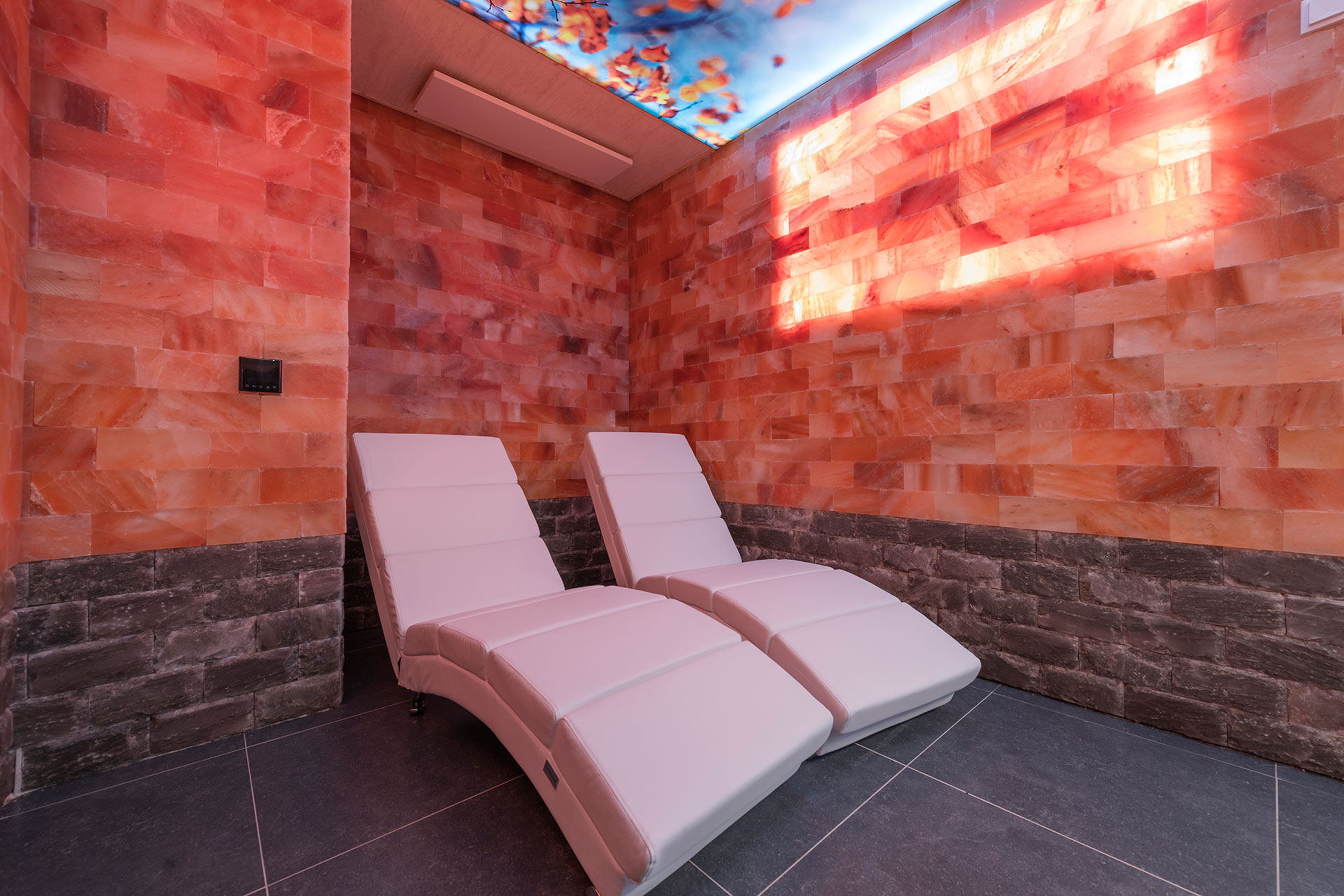What is a saltarium or salt room and who is it for?

The facility
A saltarium, or also called salt chamber, is a room whose walls and/or ceiling are covered with either white salt or Himalayan salt rock, as in our wellness.
Large chunks of Himalayan salt were fixed manually and one by one against the walls with a salt plaster without binders because they can irritate the respiratory tract and eyes.
Sometimes the floor is also sprinkled with salt but we chose an easy-to-maintain floor, for hygiene reasons.
In that space, where it is always 22°, there are some easy chairs so you can lie down and relax.
One wall of the room is entirely made of glass which means that, during your session in our saltarium, you can also enjoy and dream away with a view of the playful flames of the fireplace.
The operation
The salt stones on the walls create a certain atmosphere in the room but do not have a healing effect on the body, rather on the mind.
What does have a healing effect is the halogenerator that disperses salt aerosols in the room.
This device blows minuscule particles of salt into the room, which enter the body directly with each inhalation.
The salt crystals produce negative ions that in nature can only be found by the sea, at waterfalls or in salt caves.
A saltarium is an improved version of speleotherapy because we can control and maintain proper temperature, humidity and aerosol concentration with this new technology.
- Salt therapy increases the number of phagocytes (white blood cells specialized in detecting, digesting and destroying pathogens such as bacteria, viruses, fungi and other foreign particles that enter the body)
- It also increases the activity of macrophages, a type of white blood cells with a phagocytic effect and promote tissue repair and regulate inflammatory responses.
- In addition, halotherapy acts as a natural stimulant, improving the properties of mucus in your airways and promoting the movement of epithelial cells.
- It also helps to reduce edema in the bronchial walls and drain fluid from the bronchi, reducing stagnation.
- Salt aerosols also have a positive impact on your immune system and metabolism by, for example, increasing the levels of certain substances that help protect your respiratory system.
- Halotherapy also increases the electrophysiological activity of epithelial cells (the electrical signals and activity that takes place within epithelial cells, which form the outer layer of various organs and tissues in the body. For example, epithelial cells coat the inside of the lungs, intestines, kidneys, and many other organs and body structures) in the mucosa and improves resistance to opportunistic microflora, which can help restore a healthy balance in your airways.
- In skin diseases, halotherapy in a salt chamber has a cleansing effect and restores the biocenosis of the skin surface, improves microcirculation, has bacteriostatic and anti-inflammatory effects.
The effect of microcrystals in salt aerosol causes normalization and induction of the reparative-regenerative process in the dermis, increases skin turgor, stimulates growth and improves health.
Considering all the above properties, it can be concluded that halotherapy in a salt chamber generated with a halogen generator has beneficial effects on the respiratory system, the immune and cardiovascular systems, the skin, the vegetative nervous system and the psychic emotional sphere.
How and where did this therapy originate
Dr. Feliks Boczkowski was a physician who noticed that miners in salt caves, did not have the same respiratory and lung problems as miners in other caves.
After his research, he opened the first salt health resort at the Wieliczka salt mine in Poland in 1839.
More than a century later, in 1949, a German physician, Dr. K.H. Spannahel, initiated a study from which it became clear that people who had hidden in the salt mines during World War II had little to no respiratory problems, and he could not ignore this.
He joined forces with Hungarian geologist Dr. H. Kessler to establish the Klyutert Cave as a clinical department to further study the effects of salt therapy.
Together they laid the foundation for speleotherapy, which paved the way for halotherapy, salt therapy as we know it today.
For what symptoms does halotherapy work healing
Based on Eastern European published clinical reports, halotherapy in a saltarium is suitable for:
- Asthma
- Chronic obstructive bronchitis
- Allergic rhinitis
- Rhinosinusopathy (disorders of the sinuses)
- Chronic non-obstructive bronchitis
- Chronic brocnhitis
- Smokers
- Acute viral infection of the upper respiratory tract
- Bronchiectatic disorders
- Mucoviscidosis (cystic fibrosis)
- Chronic rhinitis
- Chornic pharyngitis
- Tonsilitis (adenoiditis)
- Chronic and acute sinusitis
- Atopic dermatitis
- Neurodermitis
- Psoriasis
- Purulent skin infections such as furuncles, abscesses, cellulitis and folliculitis
- Healing of scars after surgery
- Multi-chemical sensitivity syndrome
- Sick building syndrome (SBS)
- Persons who have been in contact with industrial and household pollutants.
How often do you go into the salt room
Halotherapy is suitable for both children and adults.
Most clinical studies have shown that the therapy works for children if they spend at least 30 minutes in the salt room and 60 minutes for adults.
Experience has shown that to obtain a beneficial effect, you need at least 3 visits per week and at least 10 sessions in succession.
It is recommended to repeat these sessions about 2 to 3 times a year.
When is it best not to use halotherapy
Halotherapy in the salt chamber is not suitable for everyone.
During halotherapy, the lymph is activated, the lungs work harder, blood circulation is accelerated, more oxygen reaches the brain, the mucous membrane can be activated, the respiratory immune system is activated.
With the following symptoms, it is recommended NOT to go into a salt room:
- High blood pressure
- Recurrent and massive bleeding of any kind
- Blood diseases in acute phase
- Acute phase of respiratory illness (cold, flu, bronchitis, pneumonia or any other infection or inflammation of the respiratory tract)
- Severe chronic breathing difficulties
- Active tuberculosis
- Mental disorders and all types of drug addiction
- Malignant diseases
- Intoxication
- Cachexia (severe and complex condition characterized by extreme muscle weakness, fatigue and weight loss)
- Pregnancy (due to insufficient studies)
- Internal diseases in decompensation
- Bleeding
- Cardiac insufficiency
- Fever




